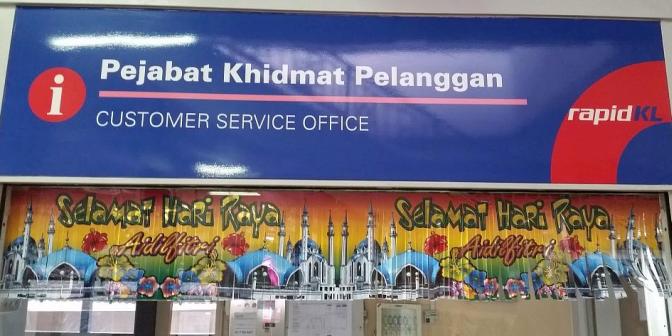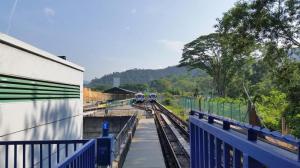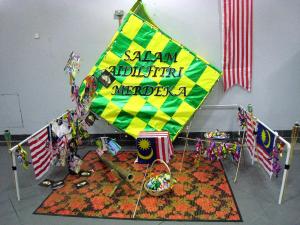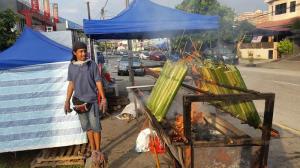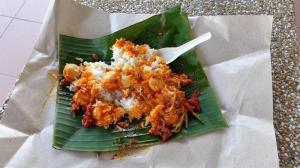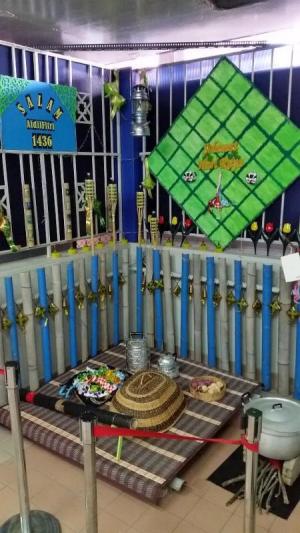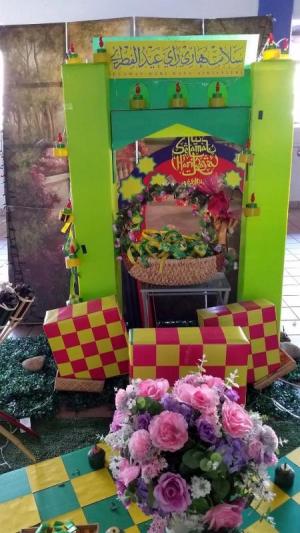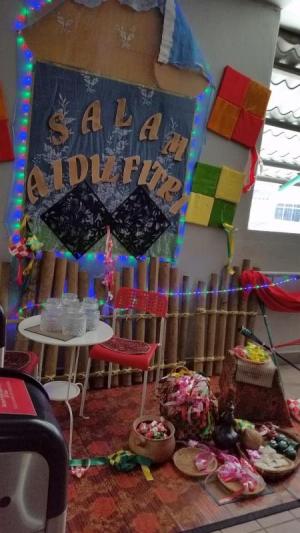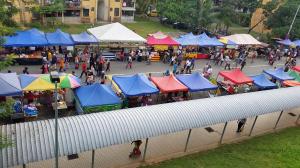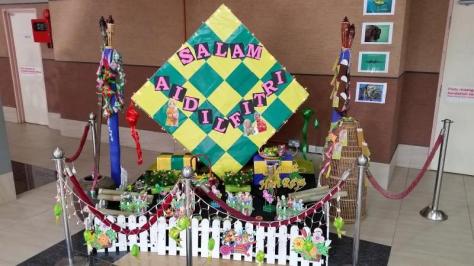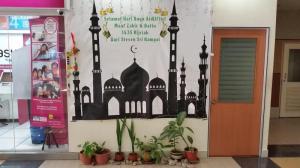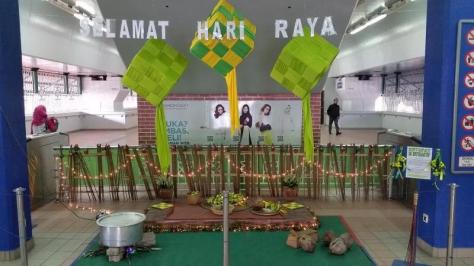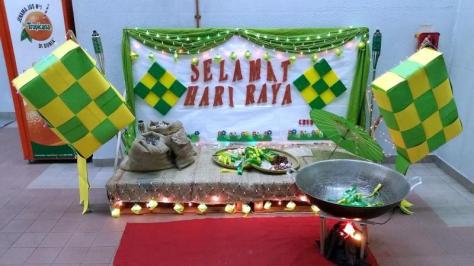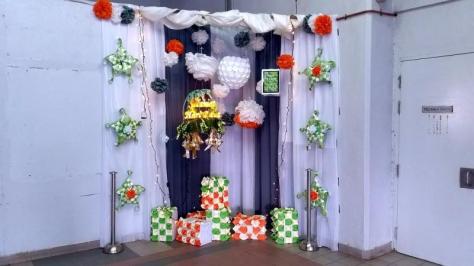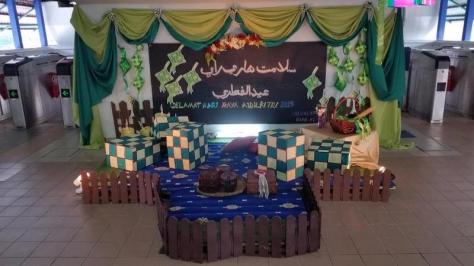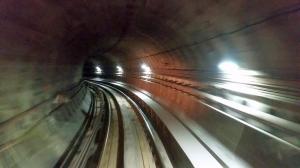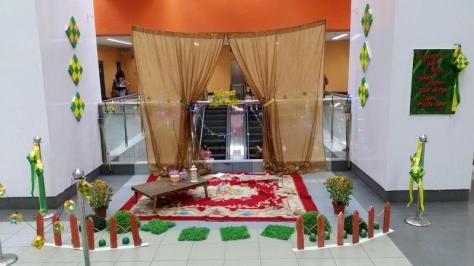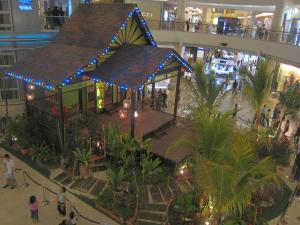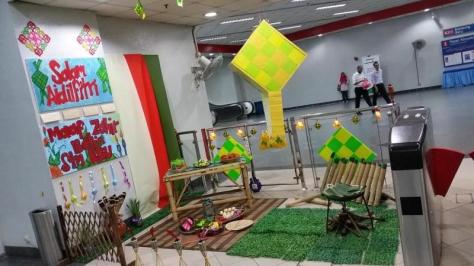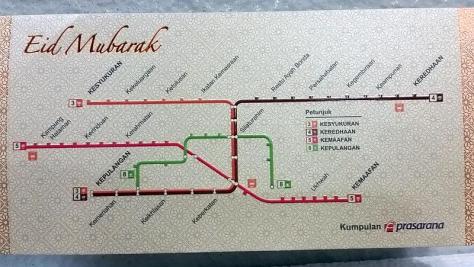Trains and tunnels, ketupats and kampungs, fasting and food and forgiveness. I take the Kelana Jaya line across Kuala Lumpur, rediscover the city, and learn how Malaysians celebrate the end of Ramadan.
Light Rail Transit and the Ketupat Challenge
Three years ago in Malaysia I was charmed by the Muslim fasting month. The array of Ramadan greeting cards in the supermarket, some with Arabic calligraphy swirling around lamps and mosques, others with comic cartoons in Malay slang I hardly understood. The vibrant colours and aromas at the evening Ramadan markets, where I’d wait with hungry locals for the prayer call to sound at dusk so we could eat. And the displays at the entrance of each Light Rail Transit (LRT) station for Hari Raya, the Malay celebration at the end of the fasting month that’s elsewhere known as Eid. Evoking both spiritual values and the rural life of yesteryear, some reminded me of nativity scenes and Christmas.
Now I’m back in Malaysia, again in Kuala Lumpur during Ramadan, and thought it could be fun to visit and photograph each station’s Hari Raya decorations. I thought it must have been done, but Google found surprisingly few shots of said station decorations. The challenge was on! What better way to reacquaint myself with the city’s geography while learning more about Malaysian culture?
The Kelana Jaya line begins at Gombak to the north-east (terminus photo above), soars over roads and rivers on elevated rails for eight stations, dives underground beneath the CBD for another five, then re-emerges for more great views past 11 more stations before it terminates at Kelana Jaya to the south-west. In all, 29 km through 24 stations. (17 km of further track and 13 new stations are under construction.) In 2012 I could list them all by heart, as both places I stayed were on this line. (For more info, see Wikipedia.)
As I set out, a whole two dozen stations seemed intimidating. Would I get through them all in one day? At least I’d already seen and shot four or five LRT displays in the past fortnight, so could leapfrog over several stops. I soon found that some Ramadan displays were inside the ticket gates and others further out, so I sometimes needed to exit the system for a clear view. This meant paying another fare, but public transport costs much less than in New Zealand and it was a chance to poke around the station, practice reading Malay signs, and search outside for food and drink.
I learnt from station staff that Rapid KL, the public transportation operator, sets an annual theme for their Hari Raya decorations. One year it was kampung or village. The end of Ramadan brings the country’s biggest holiday (like Christmas in the West), when Malays gather with family in their home town for a week or so. Malaysians share a sense of nostalgia for this “balik kampung” or return to the village, and malls throughout Kuala Lumpur have life-size models of village houses (see The Star’s 2015 photos here). The day before Hari Raya two weeks ago 1.6 million vehicles clogged the highways out of town.
When I was here three years ago Hari Raya fell near Malaysia’s Independence Day so, I learnt, Rapid KL had a combined Merdeka (Independence)-Raya theme. This explains why the 2012 LRT station displays included so many Malaysian flags, as in the photo above. Last year’s Hari Raya motif on the LRT was mosques. For 2015 the theme is “ketupat”.
Ketupats are pouches the size of a small fist in the shape of a diamond or a triangle. They resemble items woven from flax by New Zealand Maori. In one market I watched women wind ribbons of coconut palm leaf around the fingers of one hand, then tuck and turn and pull and presto – the ketupat was done! The pouches are filled with rice and boiled until it expands and is compressed into a dense lump. They are then cut open, and the rice cake typically diced and served with spicy beef rending or satay. Over Hari Raya ketupats adorn greeting cards and posters, dangle on shiny green and yellow ribbons, and twinkle in chains of lights like on a Christmas tree. You’ll see plenty below. (See Wikipedia on ketupat.)
Setting out with Lemang
Last Wednesday morning I left my guesthouse and walked to station number 7, Dato’ Keramat. My dictionary defines “keramat” as a place that is “holy and sacred, endowed with supernatural or magical powers (such as the ability to cure sickness)” – an auspicious stop for my start. On my way I passed a rack of bamboo tubes over a charcoal barbecue, like some infernal pipe organ as it billowed with smoke above the flames. These were another Hari Raya special of lemang. Hollow bamboo is lined with banana leaf and filled with glutinous rice and coconut milk. Once cooked for several hours and cooled, the tubes are split open with a machete. The compressed rice is sliced into disks and served much like ketupat rice cakes, with a more smoky-coconut flavour. Lemang are in hot demand during Hari Raya – some stalls prepare hundreds per day. Look out for bamboo tubes in the Raya photos below.
From Dato’ Keramat station I worked my way to the northern end in almost vacant trains, gloating to see the city-bound coaches were packed. I then shot back to Damai station, jumped over Ampang Park and KLCC where I planned to eat dinner, and continued stop by stop to the far end (bar another jump over Taman Jaya and Asia Jaya where I’d been the night before). For our photo journey online, however, let’s embark at the northern terminal of Gombak and track through the stations in order.
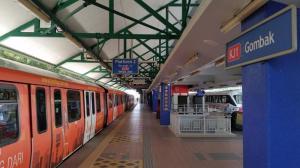 KJ1 – Gombak
KJ1 – Gombak
Serenity at the end of the line, almost in the jungle, with the vapour trail of a plane hanging still in the sky. There’s a parking building for commuters and buses leaving for the Genting Highlands and Batu Caves. The Hari Raya display was tucked behind the ticket office, so I had to swipe out of the station. I bought nasi lemak for a classic Malaysian breakfast: rice cooked in coconut milk, with salty anchovies, peanuts, spicy sambal sauce and – in this case – quail eggs. Wrapped in a tetrahedron of banana leaf for RM3 (NZ$1.20).
As well as toy ketupats dangling from the bamboo fence and filling a cane basket, the Gombak display featured other items I’d see all day. A metal and glass kerosene lantern, wick lamps on poles and models of oil lamps or pelita that flicker along pathways to village houses during Ramadan nights. There was a mock wood fire under a pot for boiling the ketupats, a silver bowl and teapot for rinsing fingers before eating, and a basket of white and purple onions. Later stations added baskets of cinnamon sticks, red peppers, or other spices.
The greeting on the big green diamond (with the cute little train fronts) is in Malay – “Selamat Hari Raya”, while the poster at left is in Arabic – “Salam Aidilfitri”. 1436 indicates the current Muslim year of 1436 AH, the number of lunar years (354 days) since the Hijra, Mohammed’s move from Mecca to Medina in 622 AD.
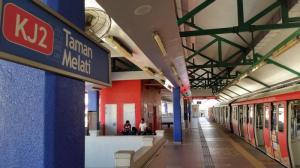 KJ2 – Taman Melati
KJ2 – Taman Melati
This station featured more pelita and ketupats, and pink artificial flowers which looked more like a bouquet in my granny’s house than a Malay artefact. There was also a greeting from the staff, roughly reading:
A blessed Aidilfitri from Rapid KL. We workers of the Taman Melati station wish you happy Hari Raya, complete forgiveness [more on this in Part Two], and a safe journey to your village. Drive carefully. Be careful on the highway. Remember, dearly loved ones are waiting your return as a family.
We pass a pretty mosque dome, pink with daisy patterns above the lush green undergrowth, then corrugated iron roofs scattered among the foliage, before tidy rows of tiled roofs and Chinese restaurants announce the next stop.
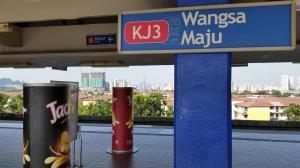 KJ3 – Wangsa Maju
KJ3 – Wangsa Maju
I simply shot this display over the ticket barriers.
I loitered here a few weeks ago at the neighbouring Ramadan Bazaar (see Timeout KL feature), where I bought the new-fangled fusion of Maggi murtabak (see Wikipedia): instant noodles fried in a batter pancake.
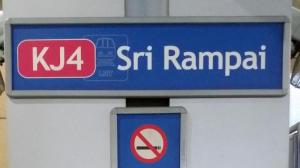 KJ4 – Sri Rampai
KJ4 – Sri Rampai
This year’s display included paper figurines in a garden and a cane trap for fishing in rivers (at right). From it dangled small envelopes for “duit raya”. The National Bank reported withdrawals of RM 500 million the day before Hari Raya this year, 90% in one and five ringgit notes. This is given in green envelopes to children as they visit houses with Hari Raya greetings. The paper estimated that 5 million Muslim children 14 years old or under might receive five ringgit at each of 20 neighbourhood houses, making RM 100 or NZ $40 each. This Malay tradition combines Muslim giving of alms, especially at Ramadan, and the red Ang Pow packets of cash delivered at Chinese New Year. It reminds me of Halloween trick-or-treating in Colorado when I was six, filling my pumpkin-shaped bucket with candy as I knocked on doors around the block.
A mosque from last year’s decorations (1435 AH) hung on a back wall.
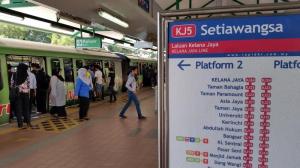 KJ5 – Setiawangsa
KJ5 – Setiawangsa
Cubic cloth ketupats above coconuts on the floor. There was also a “Pearl Word Corner” with posters of quotes like “Success comes in a can, not a can’t” and “We can complain because rose bushes have thorns, or rejoice because thorn bushes have roses” (Abraham Lincoln).
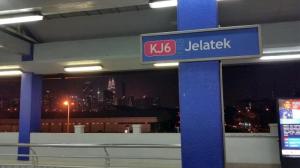 KJ6 – Jelatek
KJ6 – Jelatek
One of my two closest stations, where I often embark. An electric flicker in this fire, and I saw people posing for photos with the parasol. Outside the station is a muddy lot covered in yellow cranes and again I hope construction won’t quench the city’s soul. From the last stretch of track I saw a billboard by the motorway, “Sayangi Kuala Lumpur” or “Love KL”, and I do!
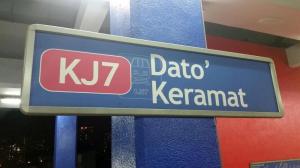 KJ7 – Dato’ Keramat
KJ7 – Dato’ Keramat
Ketupat pentagons, strange frilly balls, and the apt (though misspelt) message, “Keep calm and eat ketupat”. My second nearest station, where I began my tour.
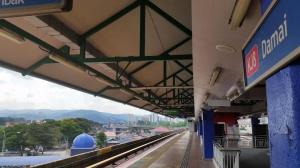 KJ8 – Damai
KJ8 – Damai
Perhaps my favourite display so far, tidy and symmetrical, with its dignified blue carpet and cushions hinting at Middle Eastern opulence. The service counter was adorned with the tinsel greetings you see in many shop windows at this time. Lots of hibiscuses, Malaysia’s national flower.
South of Damai the train dives below ground in a tunnel that’s sometimes square, sometimes round. The Kelana Jaya line is fully automated with no drivers, so there is a clear view out the front window. As we accelerate I’m reminded of the psychedelic swirling in the credits for the old sci-fi series of Dr Who.
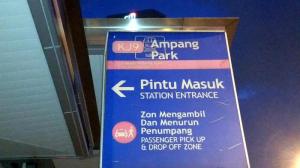 KJ9 – Ampang Park
KJ9 – Ampang Park
Here I ticked off my 24th display, the last one of the day. Like me by then, it seemed a little tired – I pushed a letter falling off back onto the poster at right, and straightened the carpet. Then I rode the escalator down to the platform, trained back to Jelatek Station, and walked the 15 minutes home.
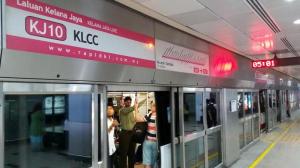 KJ10 – KLCC
KJ10 – KLCC
Traditional Raya icons, including a split open bamboo-rice lemang, plus cut-out white leaves I thought looked more Japanese. “Lebaran” is another name for the festival after the fast. Behind me two guitarists were strumming and singing at a “Busk Stop”.
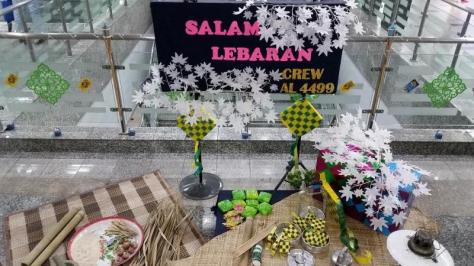
Down the station corridor is one of the city’s biggest malls, Kuala Lumpur City Centre, with a huge kampung house for Ramadan on the concourse beneath the Petronas Towers. Outside the mall is Malaysia’s biggest model ketupat, as acknowledged in July by the Malaysia Book of Records: 12m high by 9.8m wide.
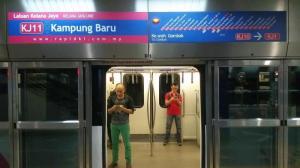 KJ11 – Kampung Baru
KJ11 – Kampung Baru
Kampung Baru is one of my favourite places in KL, a suburb of traditional wooden houses on stilts, with carved verandas and chickens on the ground and a lovely variegated roofscape of corrugated iron in autumnal shades. Not far off above the rust loom the gleaming sci-fi Petronas Towers. The bustling Ramadan Bazaar (see Timeout KL), was the first one I visited this year. I bought a Roti MacGyver for dinner – a bread roll filled with black pepper beef, all wrapped in crispy deep-fried batter. Believe it or not, that night I hung out with Chinese friends who were watching American reruns on TV (good old Fonzie in Happy Days!), and on came my first episode of MacGyver since I was a teen!
At the Kampung Baru station I especially liked the cards distributed by Prasarana, the parent company of Rapid KL, listing the virtues of Ramadan in the form of a Metro map. Peach-coloured Line 3 runs from Gratitude at top left through Familiness (how to translate such abstract nouns?), Honesty, and Bonds of Hospitality to the interchange station at Relationship where it joins brown Line 4 (coming from Willingness via Pardoning, Happiness, Friendship, and the Blessing of Father and Mother). The two lines proceed together through Blessedness, Sincerity, and Celebration and terminate at Homecoming. Pink Line 5 departs from the Village Compound, passing through stations of Nostalgic Longing, Divine Blessing and Brotherhood en route to Forgiveness.
As we’re nearly halfway to the end of the line, I hope I’ll receive Raya – Jaya forgiveness if I take a break and pick up the remaining stations in Part Two. If you’d like a break, here’s a love song to Ramadan by my favourite Muslim worship singer, a Lebanese-born Swede who also sings in Malay and tops the charts here.
You can continue the Hara Raya journey through Kelana Jaya stations 11 to 24 in Part Two.
